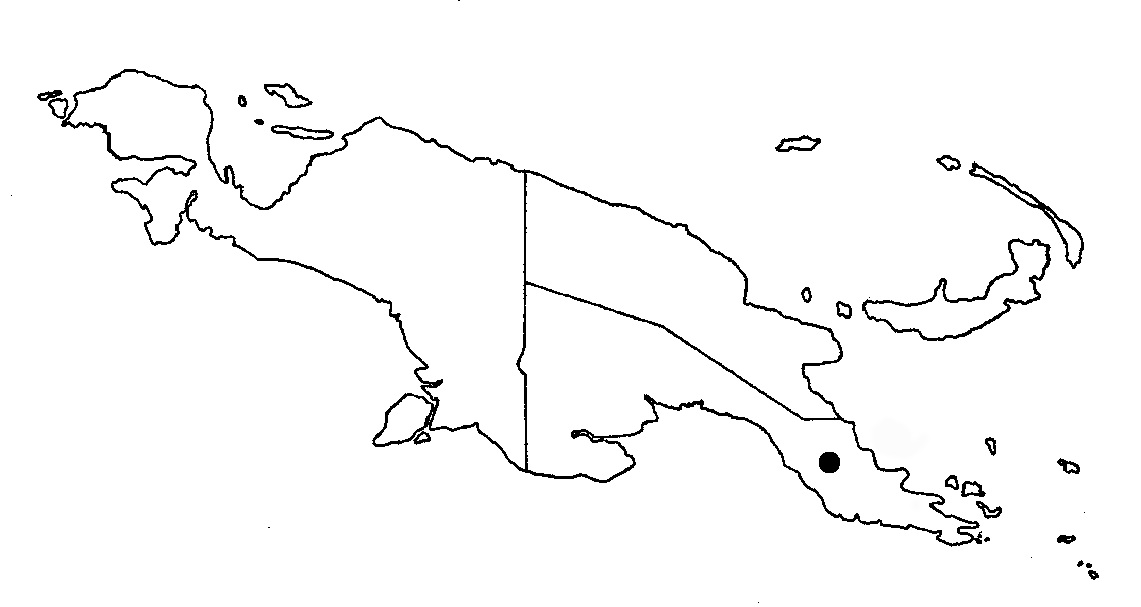
Distribution Map

Description (Barlow 1993)
Cyne papuana (Danser) Barlow, comb. novo
Amylotheca papuana Danser, Blumea 3 (1938) 38. - Decaisnina papuana (Danser) Barlow, Austral. J. Bot. 22 (1974) 540. - Type: Carr 15502 (holo L 936.295-302; iso CANB 64659, K), Papua, Isuarava, C. 4500 ft (1375 m), 10.ii.1936.
For description see Barlow, Austral. J. Bot. 22 (1974) 540 under Decaisnina papuana. Cyne papuana can be identified by its combination of young internodes dilated upwards and double-edged, leaves sessile but not cordate at the base and not united in pairs at the margins, and very short inflorescence axis 2-4 mm long bearing only 1 or 2 pairs of triads. The flowers are described as pale greyish olive in the lower part and crimson above.
Cyne papuana is known only from the type collection from New Guinea (Fig. 6), recorded at an elevation of 1375 m. Habitat details are unknown.
The species is similar to C. baetorta and C. monotrias in having inflorescences which are greatly reduced racemes of triads, so that the flowers are borne close to the stem nodes and are protected in the axils or in hollows during early development. The inflorescence of C. papuana is intermediate between these other two species in degree of reduction, and the basic structure of a raceme of triads is clearly identifiable. Cyne papuana differs from both species in its sessile leaves rounded or abruptly cuneate at the base, from C. baetorta also in having slightly more reduced inflorescences, and from C. monotrias also in having pedunculate triads with very shortly pedicellate lateral flowers, and a much less reduced inflorescence. These three species show possible links to the genusDecaisnina (see notes under Decaisnina, Cyne and C. monotrias).
In the available material it is not possible
to confirm the actual presence of an operculum covering the young
inflorescence. However the species is so similar in its vegetative
and inflorescence characters to the other species of Cyne that
it is considered to be congeneric with them. The inflorescences
are present in distinct stem hollows which are bordered by erose
flaps of cortical tissue, and it is highly likely that an operculum
is indeed present
Description (Barlow 1974)
as Decaisnina papuana (Dans.)
Barlow, comb. nov.
Amylotheca papuana Dans. Blumea 3: 38 (1938). Type.-Papua, Isuarava, c. 1360m alt., Carr 15502, l0.ii.1936 (L 936295302, holotype; CANB 64659 K (2 sheets)).
Glabrous. Stems flattened and double-edged when young, terete
when older. Leaves sessile; lamina elliptical, c. 8 by
4-5 cm, somewhat shining above, dull below, rounded but
not cordate at the base, obtuse or rounded at the apex; venation
pennate with the midrib prominent below. Inflorescences several
at the nodes; axis bearing only 1 or 2 pairs of triads, c.
2-4 mm long; peduncles of the triads c. 1 mm long;
lateral flowers of the triads almost sessile; bracts thin, acute
or obtuse, forming an involucre around each triad, 2-2 5 mm long.
Calyx cylindrical, c. 25 mm long; limb thin and flaring,
1 mm long. Corolla not seen in mature bud, probably 30 mm long.
Other parts not seen.
Occurrence. Eastern New Guinea, known only from the type locality, Isuarava (Fig. 2), c. 1360 m altitude.
Specimens Examined. EASTERN NEW GUINEA: Isuarava, c. 1360 m alt., Carr 15502, 10.ii.1936 (L; CANB; K).
Illustrations
Photographs
Cyne papuana
updated 18 January 2007